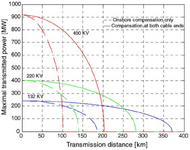aslamajec123
Electrical
for the purpose of 400kv subsea cable sizing connecting generation plant to grid, I was trying to understand to what extent Providing the Shunt reactor only at the sending end of the subsea cable circuit may help in reducing the overall current flow in the cable and if we still need to consider the full charging current of the cable in addition to Load current while sizing the subsea cable.
In this regard can you please review the below and let me know your if the below understanding is correct ?
Current flowing between Source and Shunt Reactor: The shunt reactor will indeed draw its rated inductive current from the source, and the cable will still draw its capacitive charging current. However, the vectorial sum of these currents will be reduced due to the compensation effect. This means the total current flowing from the source to the shunt reactor will be lower than the sum of the individual currents.
Reduction in Charging Current: The charging current in the cable itself is not directly reduced by the shunt reactor at the sending end. Instead, the overall reactive power demand on the source is reduced, which can improve overall system efficiency and stability.
Reduction in Reactive Current: This setup can effectively reduce the total reactive current in the cable circuit, as the inductive and capacitive currents compensate each other along the length of the cable.
In summary, while a shunt reactor at the sending end helps reduce the reactive power demand on the source, it doesn't directly reduce the charging current in the cable. A shunt reactor at the receiving end can more effectively reduce the total reactive current in the cable circuit by compensating for the capacitive charging current along the entire length of the cable.
In this regard can you please review the below and let me know your if the below understanding is correct ?
- Shunt Reactor at the Sending End:
Current flowing between Source and Shunt Reactor: The shunt reactor will indeed draw its rated inductive current from the source, and the cable will still draw its capacitive charging current. However, the vectorial sum of these currents will be reduced due to the compensation effect. This means the total current flowing from the source to the shunt reactor will be lower than the sum of the individual currents.
Reduction in Charging Current: The charging current in the cable itself is not directly reduced by the shunt reactor at the sending end. Instead, the overall reactive power demand on the source is reduced, which can improve overall system efficiency and stability.
- Shunt Reactor at the Receiving End:
Reduction in Reactive Current: This setup can effectively reduce the total reactive current in the cable circuit, as the inductive and capacitive currents compensate each other along the length of the cable.
In summary, while a shunt reactor at the sending end helps reduce the reactive power demand on the source, it doesn't directly reduce the charging current in the cable. A shunt reactor at the receiving end can more effectively reduce the total reactive current in the cable circuit by compensating for the capacitive charging current along the entire length of the cable.

